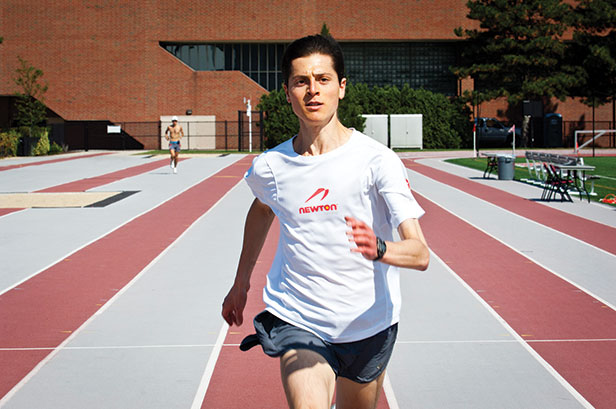
Go. Forty-five push-ups, a familiar calisthenics routine, and a cup of coffee are my Sunday-morning boot sequence. Running shorts on. Laces tied.
The playlist begins at 164 beats per minute: my comfortable, run-forever cadence. Though I tell myself it’s just for fun today, I am always calculating as I run.
My compulsive calculating started with a heartbreak in my hometown. In 2005 I ran the first half of the New York City Marathon in 1:31, but at mile 17 I couldn’t maintain my pace. Running became excruciating: I had hit the wall. I finished the second half 20 minutes slower than the first, broken, frustrated, and mystified. I was determined to understand exactly why I had crashed, optimize my training and running performance, then come back and run the course properly.
I was in my second year of a joint program at Harvard Medical School and MIT, working on both an MD and a PhD in electrical engineering, so I saw an opportunity to develop my endurance training in tandem with my academic training. The previous spring, a professor had agreed to let me skip afternoon lectures to run the Boston Marathon if I finished and returned in time to give a talk on the physiology of endurance running after the race. I have given a post-marathon lecture every year since.
Gradually, my lectures morphed into a formal mathematical model of the metabolic requirements for endurance running. Last October I published the model in PLoS Computational Biology and developed an online endurance calculator to personalize its predictions for individual runners. Within four weeks, endurancecalculator.com had served more than 100,000 requests; within a year, the article had become one of the 10 most downloaded of the 30,000-plus papers in the Public Library of Science. And after publishing my model last fall, I finished the New York City Marathon in 2:55. When I run it again this November, it will be my 21st marathon.
Today, though, I am just running for fun.
Phase one, my warm-up, is like a dance. At 55 or 60 percent of my aerobic capacity, I sync my strides with the rhythm from my playlist. Sidewalk cafés are preparing for early brunch, and I imagine I can smell damp newspapers and Sunday crossword puzzles on the doorsteps I run past. I check my footwork for efficient strides and soft, midsole landings behind my center of gravity; feel for correct posture in my lumbar spine; relax my shoulders as my arms swing in time.
I knew I would be running only 12 miles, so I made no special effort to fuel up yesterday. My parallel hybrid engine runs on fat and glycogen simultaneously, drawing more power from fat at lower intensities (below around 65 percent of my maximal aerobic effort) and transitioning increasingly to glycogen, stored in my liver and leg muscles, at higher intensities. At around 100 kilocalories per mile, I will burn about 1,200 kilocalories this morning, perhaps 800 or 900 as glycogen and the balance as fat. Runners never worry about exhausting their fat stores, as even the leanest runners carry more than enough fat for back-to-back marathons. Carbohydrate storage can become a limiting factor at distances beyond 20 miles, since the typical runner rarely stores more than 2,000 kilocalories of glycogen.
Phase two begins as I reach the running path. I play with different speeds and cadences, like shifting gears on a bicycle. Finding the most energy-efficient way to run at a given speed takes experimentation during training. In phase three I aim to float. Raising my cadence, lengthening my stride, I increase my speed—requiring more power from my muscles. Approaching 80 percent of my maximum aerobic intensity, I push myself harder over the last few miles. The final half-mile of my route loops back past the sidewalk cafés and newspapers on now sun-dried doorsteps. At top speed, though, I hardly notice. I fly past, trying to touch the ground as little as possible. Faster. Keep your form. Even faster—and then I am home. On a good day my finishing sprint brings my heart rate up to just over 180.
After cooling down, I find that I lost two kilograms on the run, which I know I will gain back by rehydrating over the next 24 hours. And the salty grit on my neck and forehead reminds me that I will have to replenish my sodium level with the equivalent of three or four grams of table salt.
I log my mileage and my time. Then the calculator powers down. It is still Sunday morning, after all.
Benjamin I. Rapoport, PhD ‘11, is currently a third-year student at Harvard Medical School.
Keep Reading
Most Popular
Large language models can do jaw-dropping things. But nobody knows exactly why.
And that's a problem. Figuring it out is one of the biggest scientific puzzles of our time and a crucial step towards controlling more powerful future models.
The problem with plug-in hybrids? Their drivers.
Plug-in hybrids are often sold as a transition to EVs, but new data from Europe shows we’re still underestimating the emissions they produce.
Google DeepMind’s new generative model makes Super Mario–like games from scratch
Genie learns how to control games by watching hours and hours of video. It could help train next-gen robots too.
How scientists traced a mysterious covid case back to six toilets
When wastewater surveillance turns into a hunt for a single infected individual, the ethics get tricky.
Stay connected
Get the latest updates from
MIT Technology Review
Discover special offers, top stories, upcoming events, and more.